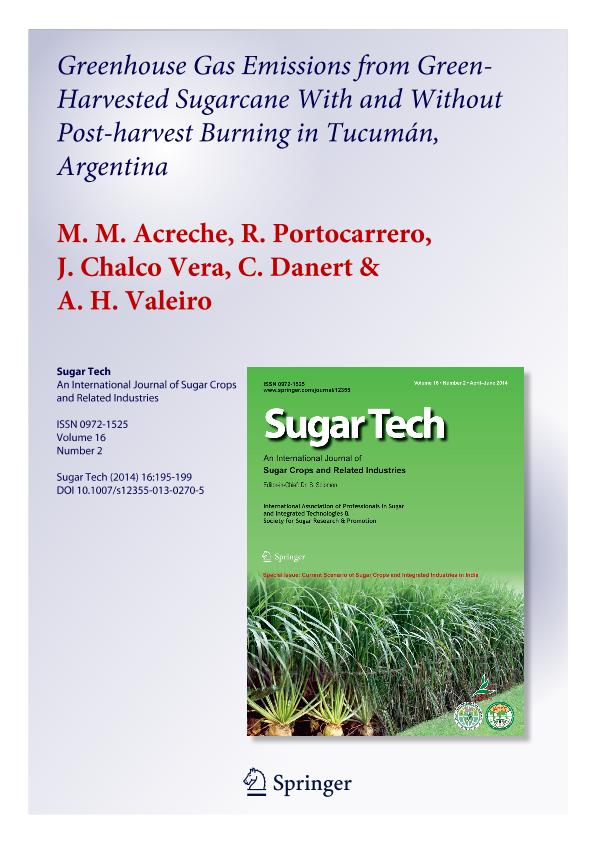Mostrar el registro sencillo del ítem
dc.contributor.author
Acreche, Martin Moises

dc.contributor.author
Portocarrero, R.
dc.contributor.author
Chalco Vera, Jorge Elías

dc.contributor.author
Danert, C.
dc.contributor.author
Valeiro, A. H.
dc.date.available
2016-08-22T20:48:37Z
dc.date.issued
2014-06
dc.identifier.citation
Acreche, Martin Moises; Portocarrero, R.; Chalco Vera, Jorge Elías; Danert, C.; Valeiro, A. H.; Greenhouse gas emissions from green-harvested sugarcane with and without postharvest burning in Tucumán, Argentina; Springer India; SugarTech; 16; 2; 6-2014; 195-199
dc.identifier.issn
0972-1525
dc.identifier.uri
http://hdl.handle.net/11336/7288
dc.description.abstract
Concentrations of greenhouse gases (GHG) in the atmosphere are increasing due to anthropogenic actions, and agriculture is one of the most important contributors. This study quantified GHG emissions from greencane harvested sugarcane with and without post-harvest burning in Tucuma´n (Argentina). A field trial was conducted in Tucuma´n during the 2011/2012 season using a randomised complete-block design with four replications. Treatments were: (a) harvest without sugarcane burning (neither before nor after), and (b) harvest with trash burnt after harvest. The method used to capture gases (CO2, CH4 and N2O) in the crop cycle was based on closed-vented chambers, while quantification was by gas chromatography. There were significant emission rates of CO2 and N2O during the sugarcane cycle in Tucuma´n, but no evidence of CH4 emissions or uptakes. N2O and CO2 emission rates were higher in the no-burning treatment than in the burnt, but only in part of the crop cycle. The former is apparently associated with the application of nitrogen fertiliser, while the higher CO2 emissions seem to be associated with trash retention. There were no significant correlations between environmental factors and emission rates. Although these results seem pessimistic, in the context of an entire crop GHG balance (including the emissions due to burning before or after harvest) green-cane harvesting without burning could effectively lead to a reduction of total GHG emissions during the crop cycle.
dc.format
application/pdf
dc.language.iso
eng
dc.publisher
Springer India

dc.rights
info:eu-repo/semantics/openAccess
dc.rights.uri
https://creativecommons.org/licenses/by-nc-sa/2.5/ar/
dc.subject
Carbon Dioxide
dc.subject
Nitrous Oxide
dc.subject
Methane
dc.subject
Emission Rates
dc.subject.classification
Ciencias Medioambientales

dc.subject.classification
Ciencias de la Tierra y relacionadas con el Medio Ambiente

dc.subject.classification
CIENCIAS NATURALES Y EXACTAS

dc.title
Greenhouse gas emissions from green-harvested sugarcane with and without postharvest burning in Tucumán, Argentina
dc.type
info:eu-repo/semantics/article
dc.type
info:ar-repo/semantics/artículo
dc.type
info:eu-repo/semantics/publishedVersion
dc.date.updated
2016-08-17T15:39:33Z
dc.journal.volume
16
dc.journal.number
2
dc.journal.pagination
195-199
dc.journal.pais
India

dc.description.fil
Fil: Acreche, Martin Moises. Instituto Nacional de Tecnología Agropecuaria. Centro Regional Tucumán-Santiago del Estero. Estación Experimental Agropecuaria Famaillá; Argentina. Consejo Nacional de Investigaciones Científicas y Técnicas. Centro Científico Tecnológico Tucumán; Argentina
dc.description.fil
Fil: Portocarrero, R.. Instituto Nacional de Tecnología Agropecuaria. Centro Regional Tucumán-Santiago del Estero. Estación Experimental Agropecuaria Famaillá; Argentina
dc.description.fil
Fil: Chalco Vera, Jorge Elías. Instituto Nacional de Tecnología Agropecuaria. Centro Regional Tucumán-Santiago del Estero. Estación Experimental Agropecuaria Famaillá; Argentina. Consejo Nacional de Investigaciones Científicas y Técnicas. Centro Científico Tecnológico Tucumán; Argentina
dc.description.fil
Fil: Danert, C.. Universidad Nacional de Tucumán. Facultad de Agronomía y Zootecnia; Argentina
dc.description.fil
Fil: Valeiro, A. H.. Instituto Nacional de Tecnología Agropecuaria. Centro Regional Tucumán-Santiago del Estero. Estación Experimental Agropecuaria Famaillá; Argentina
dc.journal.title
SugarTech
dc.relation.alternativeid
info:eu-repo/semantics/altIdentifier/url/http://link.springer.com/article/10.1007/s12355-013-0270-5
dc.relation.alternativeid
info:eu-repo/semantics/altIdentifier/doi/10.1007/s12355-013-0270-5
dc.relation.alternativeid
info:eu-repo/semantics/altIdentifier/doi/http://dx.doi.org/10.1007/s12355-013-0270-5
Archivos asociados
